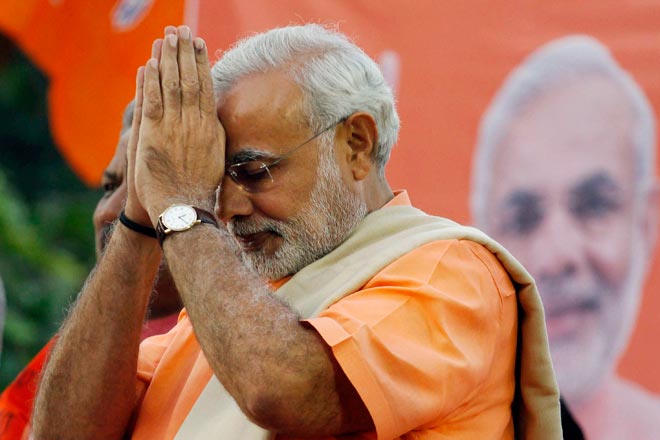For the 16th time in its history the world’s largest democracy is going to the polls. Social cohesion, economic growth and the fight against corruption dominate the headlines but what about the implications for the environment? Jonathan Galton investigates.
It has been called ‘jaw-droppingly enormous’ (Washington Post) and the ‘greatest show on earth’ (The Economist). As far as the exercise of the democratic process is concerned, this is no hyperbole. By sheer numbers, India’s 16th general election lords it over the democratic world – an electorate of over 800 million (compare the US’ 200 million in 2012) are choosing from an estimated 15,000 candidates at nearly a million polling stations over the course of five weeks. At the national level, two giant coalitions – the United Progressive Alliance (starring the incumbent Congress Party) and the National Democratic Alliance (dominated by the socially conservative Bharatiya Janata Party) slug it out, joined by a fresh new voice in politics, the anti-corruption Aam Aadmi Party, or Party of the Common Man.
Big, chunky issues – the economy, corruption, employment, secularism – are under debate, and for many, climate change and sustainable development are way down the list of concerns. While this is understandable, it is also true that India’s cities are polluted, its roads congested and its waterways filthy conduits of disease. Alongside its rise to global prominence the country has become the world’s third biggest carbon emitter but this is rarely mentioned. Here I take a look at the three biggest contestants – the BJP, Congress and Aam Aadmi Party – in an attempt to understand this neglected issue.
Bharatiya Janata Party (BJP)
With origins in Hindu nationalism, the BJP rose to prominence in the 1980s and has so far produced one Prime Minister, Atal Bihari Vajpayee (1998-2004). Chosen candidate Narendra Modi, a self-described Hindu nationalist and current Chief Minister of Gujarat, has only recently shaken off over years of boycotts by the US and UK following his alleged failure to curb anti-Muslim violence in his state in 2002. Now, with a superstar status and widely tipped to be India’s next PM, “NaMo” is equally famous for the economic growth model he pioneered in Gujarat – a business-friendly small government which welcomes multi-nationals with a warm neo-liberal handshake and reduced taxes – dubbed “Modinomics”.
Some suggest that a Modinomic government would be bad news for the environment – a recent Hindustan Times article described the prospect as a “development disaster” with growth coming at the expense of air quality, water security and rural livelihoods. Others point to the BJP’s investment in renewable energy, especially in Gujarat, as evidence that Modi’s red-tape-slashing dynamism is just what India needs.
The party’s manifesto lists “Inclusive and Sustainable Development” within their Ek Bharat – Shrestha Bharat (“One India, Best India”) pledge. A more detailed reading reveals a focus on energy security by maximising the potential of coal and oil as well as cleaner fuel sources. It is stated that the “BJP considers energy efficiency and conservation crucial to energy security” and that climate change mitigation will be taken seriously, although according to environmental activist Rishi Aggarwal this means “absolutely nothing” if the track record of the BJP in its existing power bases is anything to go by.
Surprisingly little is made of Modi’s 2010 book, Convenient Action: Gujarat’s Response To Challenges Of Climate Change. Granted, it has not had the impact of Al Gore’s An Inconvenient Truth but kudos nevertheless to Modi for writing on the subject. Predictably, the book seems to have been met with a mix of sycophancy and derision, and has been accused of simply showcasing pet projects – some of dubious environmental benefit such as the ecologically controversial Sardar Sarovar Dam – rather than presenting a coherent argument.
The verdict? A Modi-led government may create the right conditions for the renewables sector to flourish but this gung-ho approach could also result in energy-intensive, ecologically-detrimental and perhaps socially-inequitable development.
Indian National Congress
Congress has dominated Indian politics since Independence with seven Prime Ministers including the incumbent Manmohan Singh as well as three members of India’s premiere political dynasty – Jawaharlal Nehru, Indira Gandhi and her son Rajiv. The current party chairperson is Rajiv’s widow, Italian-born Sonia Gandhi while the candidate for PM is his son Rahul.
Traditionally left of centre and pro-poor, many view the party as weakened by bureaucracy and corruption today. Where the environment is concerned they have some form, having created the Ministry of New and Renewable Energy and the Ministry of Environment and Forests (MoEF). Jairam Ramesh who led the latter from 2009-2011 was noted for his assertive style which included delaying some major construction projects, speaking out against fuel-guzzling cars and, controversially, suggesting at the Cancun climate talks that India might be open to committing to binding emissions cuts.
That said, an expert I spoke to who asked not to be named described Congress’ recent record on the environment as “abysmal”, pointing to the “emasculation” of the MoEF, now headed by Veerappa Moily who also just happens to be the Minister for Petroleum and Natural Gas. Manmohan Singh has made it clear that he feels rich nations are responsible for the bulk of greenhouse gas emissions and should therefore shoulder the main burden of climate change mitigation. Sonia Gandhi, meanwhile, has stressed the need for women’s voices to be heard in the climate change debate, while her son Rahul is not noted for his public pronouncements on the subject.
Like the BJP, Congress’ manifesto prioritises economic growth and there is promise of regulatory reform including around the issue of environmental clearances for new development projects. The Environment section – more detailed than the BJP’s – pledges to continue implementing the National Action Plan on Climate Change and to introduce a system of “Green National Accounts” whereby the costs of environmental degradation will be reflected in India’s national accounts. While the latter is a laudable aspiration it is not entirely clear how this information will actually be used.
Meanwhile, despite criticism from the BJP that Congress is using environmental clearance regulations to control big business, the evidence on the ground – new airports and coal power stations approved under Congress’ watch – suggests that there is little to choose between the two parties in the way they let economic growth trump environmental protection.
Aam Aadmi Party (AAP)
The newest kid on India’s political block, the Aam Aadmi (“Common Man”) Party launched in late 2012 following activist Arvind Kejriwal’s decision to step into politics. Having quit his job as a civil servant in 2006, Kejriwal set up an NGO to promote transparency in government and has since made corruption claims against high profile establishment figures including Sonia Gandhi’s son-in-law. By late 2013 his AAP took control of Delhi’s legislative assembly, only to resign after 49 days after its failure to pass a bill to appoint an independent body to monitor political corruption. Undeterred, Kejriwal is now running head-to-head against Narendra Modi in Varanasi, India’s holiest city.
As might be expected, the AAP manifesto has a strong focus on managing corruption, arguing that true swaraj (self-rule) will not be achieved until India is ruled by its people not by self-interested bureaucrats. There is also an emphasis on decentralisation of power and, as Kejriwal put it in an interview with AGI late last year, a “bottom to top approach” where village and town councils are given untied funds every year. Where the environment is concerned, it is interesting to note that Economy and Ecology are linked in a single section although a large part of the section is devoted (perhaps understandably) to the rural economy. The single “Environment and Natural Resources Policy” does not mention climate change explicitly but stresses the role of local communities in managing natural resources with the support of a reformed Ministry of Environment and Forests. It also calls for a phased shift towards renewable energy (locally-owned, of course) and a priority focus on local water resource management.
Kejriwal has a history with water – as Chief Minister of Delhi he successfully delivered on a promise of 700 litres per day of free water for Delhi households with punitive costs for those exceeding this limit. He later announced reductions in electricity tariffs across Delhi and additional bill waivers as a reward for those who had, under his encouragement, refused to pay their electricity bills in 2012-13 in protest over price hikes. This headline-grabbing approach to fuel poverty might spell a golden opportunity to raise awareness of sustainable resource management but Rishi Aggarwal is sceptical, warning that in the fight for votes the AAP can only promote populist policies which may not be in the best interests of sustainable development. Far more effective, he argues in his recent publication The Futility of Aam Aadmi Party versus the Promise of Active Citizenship, would be for individuals to engage with issues at the grassroots level rather than waiting for the elusive dream of political reform.
Sustainable futures?
Let’s not beat about the bush. Modi’s book notwithstanding, India has no Green Messiah among its mainstream politicians. Climate change and sustainable growth are not big ticket issues in this election and it is not hard to sympathise with the view that India has many more pressing concerns. Congress appears to have a (marginally) better track record than the others, but recent performance has hardly been inspiring and Rahul Gandhi has not indicated any great passion for the subject. BJP’s Narendra Modi, generally tipped as the next PM, has a can-do approach to development including renewable energy projects in Gujarat, but there is a risk that his enthusiasm for growth will run roughshod over environmental concerns. And the AAP? Who knows what Arvind Kejriwal’s drive for decentralisation and affordable fuel could mean for the bigger picture of India’s sustainable growth? Definitely a space worth watching. In the meantime, important as the next government could be, equally if not more important are the private and not-for-profit sectors and, above all, India’s billion plus population. If a meaningful approach to climate change and sustainable development is to be achieved, India needs active, engaged citizens more than ever.







